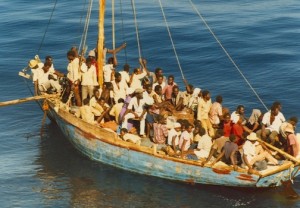Haitian Refugees’ Odyssey by Boat to Guantánamo Bay
National Dialogue and Traveling Exhibit

Haitian refugees escaping political and economic turmoil were rounded up on the high seas and taken to Guantánamo, where they were detained in tent cities while their futures were debated.
I found studying images, maps, and videos of GTMO to be an enlightening experience. The Guantánamo Public Memory Project (GPMP) website covers the history of Guantánamo Bay, Cuban history, as well as news and updates on the post 9/11 era. One of the things that I found especially informative, and that I could to relate after spending hours working with GPMP materials is an image of Haitian refugees in a boat fleeing to Cuba in search of freedom. During the 1990s, Haitian refugees held at GTMO were stopped in transit on their odyssey to the U.S in search of a better life. When Haitian refugees tried to enter the United States, only a small percentage of Haitians were admitted to the U.S. The Immigration and Naturalizations Service (INS) typically accepted only those who were believed to have economic value. Haitians refugees had to wait a very long time to be admitted to the United States. They were detained in Guantánamo Bay and tested for HIV/AIDS. Those who tested positive were held in especially bad conditions.
The idea of favoring Haitian refugees for economic purposes reminded me of my high school economics teacher who migrated from Spain. Jose came into the U.S as an international student. He had been applying for a green card for fourteen years and he contributed to the economy massively through his education and tax out of his paycheck. Jose didn’t qualify for asylum simply because he was not considered a refugee at the time as Spain was peaceful. Jose’s story of being refused asylum connects to the many Haitian refugees who were declined for asylum eligibility and the relative few who were admitted for economic reasons by the United States.
Moreover, this story of Haitian refugees reminded me of the practice of “convict leasing” in the history of southern states in the U.S. The whole idea of the “convict lease” was using prisoners for labor as a punishment for their alleged crimes. The idea of imprisoning black people accused of crimes wasn’t enough punishment but rather inmates were punished by being forced to work, often on farms. As a consequence for their alleged crimes, prison officials made the inmates work countless hours every day. The southern states profited economically from inmates’ labor. The inmates weren’t refugees in the same sense of Haitian refugees in the 1990s, but their similarity is that their labor contributed to the U.S.
Posted by Sadiq Mohamud—Sociology BA at University of Minnesota
